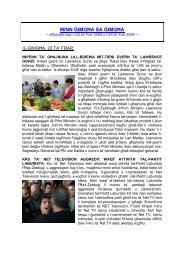Dr & Mrs gonzi - MaltaRightNow.com
Dr & Mrs gonzi - MaltaRightNow.com
Dr & Mrs gonzi - MaltaRightNow.com
You also want an ePaper? Increase the reach of your titles
YUMPU automatically turns print PDFs into web optimized ePapers that Google loves.
| | LIFE&STYLE NUTRITION |L&S bodyCliff Sultana Dip.PT (UK) Last month we touched on the subject of food labelling; specifically fats, carbohydratesand proteins which make up the kcals figure in the nutrition data section. In this issue we’lllook into the ingredients listed on food labels – where those obscure ingredients <strong>com</strong>e from andwhat to look out for. Whether you’re a vegetarian, are worried about food allergies, or simplytrying to stay healthy, we’ll discuss (albeit briefly) the good and the bad, natural and unnaturalingredients, so the next time you go shopping for food, you’ll only buy what you really want to eat.Food Additives‘A food additive is something deliberately added to food which isn’tusually considered a normal ingredient, and which is likely to still bein the food (in some form) when you eat it.’ – In layman’s terms asdescribed by the BBC’s website.There are around 2500 food additives in use and these are growing byabout a 100 every year. Most of them are artificially produced but someare derived from natural sources such as E120 (Cochineal – made fromcrushed insects).The general assumption is that additives are bad and should beavoided at all costs. This is not always the case. Additives, suchas sugar, vinegar and salt, have been used for centuries to flavour,preserve and colour food. So, unless you consume all your food a shorttime after it’s been harvested, additives are necessary to preserve foodbeyond their natural life.E-numbers are used to show food additives that are legally permittedby the European Union, though not all additives possess an E-number.This last type will normally be listed on the label in its name formrather than as an E-number. There are a number of functions for whichadditives are used. Unfortunately we don’t have the space to list themall, but I have included a small table taken from the BBC websitewhich gives an indication of the range of E-numbers and their use:Principal Function GroupingsFunctionRangeColourings 100-181Preservatives 200-285 and 1105Antioxidants 300-340Acidity Regulatorsvarious numbersThickeners / Emulsifiers 322, 400-499 and 1400-1451Anti-caking Agents 550-572Flavour Enhancers 600-650Glazing Agents 900-910Sweeteners 420, 421, 950-970There are a small number of additives which have been shown to haveunpleasant side effects and, in worst cases, allergic reactions. Most ofthese additives can either be discarded <strong>com</strong>pletely (like food colouringwhich is purely aesthetic) or can be replaced by natural sources. Have alook at - http://intranet.yorkcollege.ac.uk/yc/new/hospitality/hospcat/5.html - which lists 50 food additives which would best be avoided.Food AllergiesThe Concise Oxford Dictionary defines the term ‘allergy’ as - a damaging immune response by the body to asubstance to which it has be<strong>com</strong>e hypersensitive. The substance in a food that causes an allergic reaction iscalled an allergen. An allergic reaction can be produced by a tiny amount of the ingredient that a person issensitive to.It is important to note that food allergy is not the same as food intolerance. In food intolerance the immunesystem is not involved and the symptoms are milder than those of an allergic reaction. Typical food intolerancewould be lactose, where the person does not have the necessary enzymes to break down milk sugar.Since November 2005, all pre-packed food sold in the UK has to clearly show any ingredients (such as nuts,eggs and soya) that may cause an allergic reaction. Some food ingredients made from these foods will notcause an allergic reaction because they have been refined and so do not have to be labelled.Some manufacturers choose to indicate on the label if a certain food could have gotten into the product by accident,during the manufacturing process, transport or storage. This is called ‘cross-contamination’, and it is at themanufacturer’s discretion whether to show it on the label. So if you have to avoid certain ingredients, choose onlyproducts that state ‘free from…’ or ‘…free’. That way you can be sure that there are no traces of the food.VegetariansWhen it <strong>com</strong>es to food labelling on pre-packaged foods, vegans and vegetarians have no easy meansto identify whether the food is suitable. In the UK the Food Standards Agency has issued guidelines tomanufactures so they can more clearly label foods which are suitable for vegetarians and vegans.These are only guidelines though, and the choice of whether to include the information on the label still restswith the manufacturer. And more confusing still, different manufacturers, shops and supermarkets have theirown rules for labelling, without knowing exactly what their criteria are.In this respect the list below, based on information from the BBC Food website, highlights some ingredientsto look out for.E901: beeswax used as a glazing agentE207: lactic acid derived from milkAlbumen: egg white, mostly found in baked goodsAnchovies: found in Worcestershire sauce, shrimp paste and fish sauceAnimal fats: sometimes found in biscuits and cakes. Can also be found in margarines, spreads and ice-creamGelatine: made from animal ligaments and bones. Used as a setting agent in sweets (especially chewy ones),nutritional supplements (capsules), ice-creams, jellies, mousses, yoghurts and panna cottaRennet: enzyme extracted from the stomach lining of calves. Found in hard cheesesVitamin D3: derived from sheep’s wool. Found in margarinesWhey: a by-product of the cheese making process where rennet has been used. Found in crispsThis is only a brief insight into the mystery that is reading food labels. In my research I came across some varyconfusing legislation and guidelines as to what can or cannot be listed on a food label. Despite this I hope thatafter reading this article you can make your next visit to the supermarket a more knowledgeable one. L&s | DECEMBER ’07 31







![Sandro Chetcuti akku]at b'attentat ta' qtil - MaltaRightNow.com](https://img.yumpu.com/50098970/1/174x260/sandro-chetcuti-akkuat-battentat-ta-qtil-maltarightnowcom.jpg?quality=85)








![Malta tibqa' ]]omm mal-po]izzjoni li ddikjarat fis-summit](https://img.yumpu.com/44301444/1/174x260/malta-tibqa-omm-mal-poizzjoni-li-ddikjarat-fis-summit.jpg?quality=85)